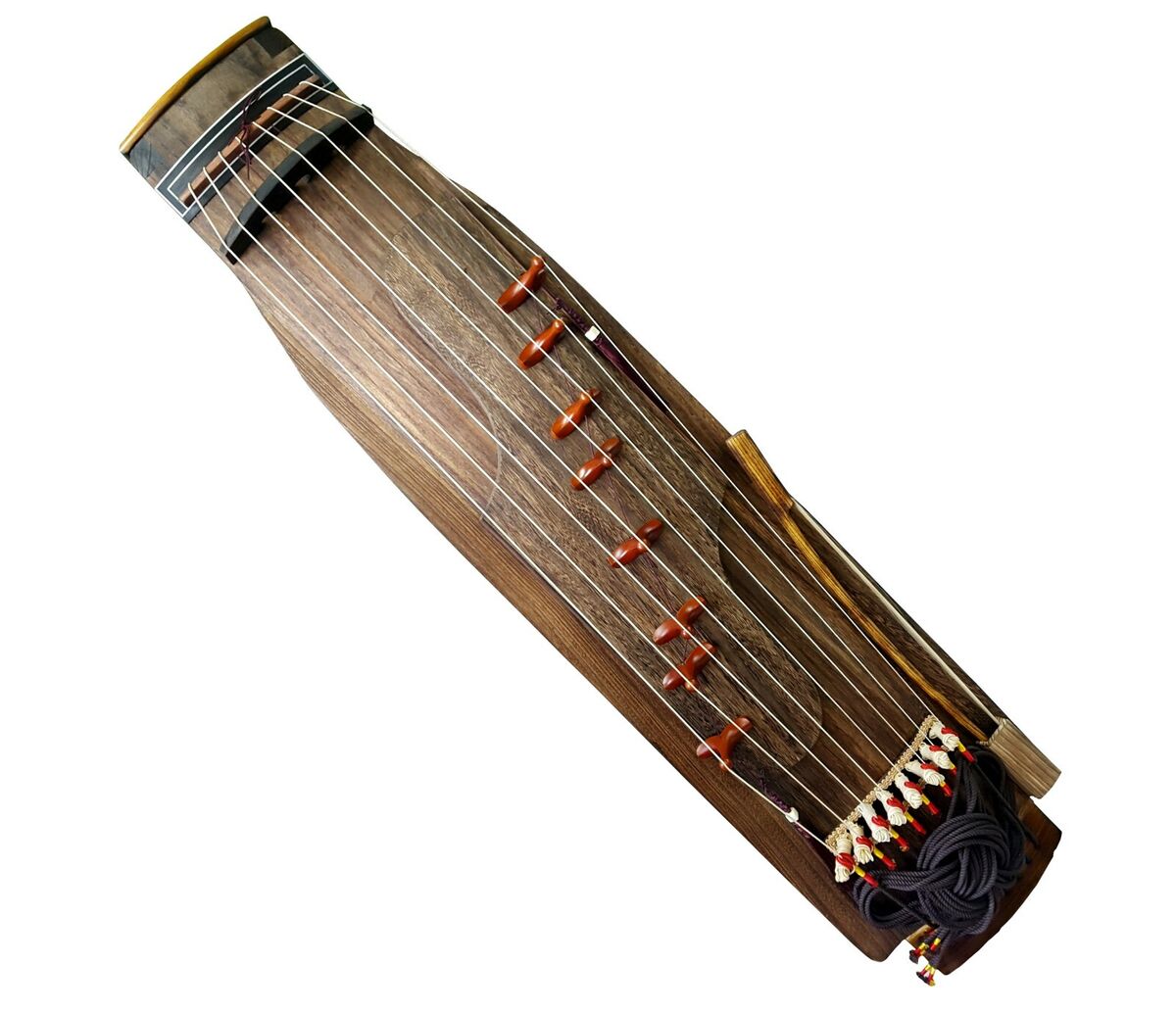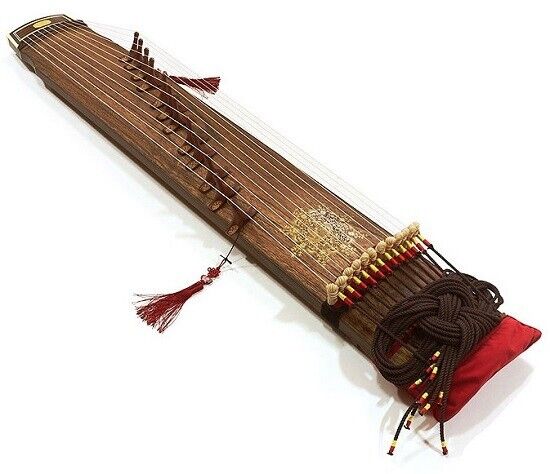Ajaeng
Bowed Instruments
Asia
Between 1001 and 1900 AD
Video
The Ajaeng is an ancient Korean stringed instrument that holds a significant place in Korean traditional music. Known for its deep, resonant sound and distinctive appearance, the Ajaeng has been an integral part of Korean folk and court music for centuries.
History and Origins of the Ajaeng
The Ajaeng has a long and storied history, with its origins dating back to ancient Korea. While the exact timeline of its development is not entirely clear, it is believed to have been introduced during the Goryeo Dynasty (918–1392), a period known for its flourishing of the arts and culture. The instrument is often considered to be a variation of the larger family of zither-like instruments, such as the Chinese guzheng or the Japanese koto, but with distinct characteristics that reflect Korean traditions.
The name “Ajaeng” is thought to be derived from the Korean words “a” (아) meaning “great” or “big” and “jaeng” (쟁) referring to a stringed instrument. The Ajaeng is typically referred to as a “Korean zither” because of its shape and the way it is played, but its unique features set it apart from other zither instruments.
During the Goryeo Dynasty, the Ajaeng was primarily used in royal courts and Buddhist temples for ceremonial purposes. It was valued for its ability to evoke deep, meditative tones, and it became an important part of the court’s musical ensemble. The instrument was often used in ritualistic and spiritual contexts, where its resonant sound was believed to bring a sense of tranquility and focus. Over the centuries, the Ajaeng’s role expanded beyond the royal courts and religious settings. It became a popular instrument in traditional Korean folk music, particularly in performances of court music (Jeongak) and narrative music (Pansori). The Ajaeng also found its way into smaller folk ensembles and was commonly played by skilled musicians who could produce a variety of tonal effects through different playing techniques.
The Ajaeng remained an important part of Korea’s musical landscape throughout the Joseon Dynasty (1392–1897) and into the 20th century. However, as Western musical instruments became more prevalent in Korea during the modern era, the Ajaeng gradually declined in popularity. Despite this, the instrument has experienced a resurgence in recent years, as musicians and scholars have rediscovered its unique sound and its connection to Korea’s cultural heritage. Today, the Ajaeng is often performed in traditional ensembles and is still used in various cultural performances, including those that showcase Korean court and folk music.
The Working Mechanism of the Ajaeng
The Ajaeng is a stringed instrument that is played by plucking, strumming, or bowing the strings, depending on the desired sound and technique. Its construction, playing technique, and unique sound distinguish it from other stringed instruments. To fully appreciate the Ajaeng, it is essential to understand its working mechanism, from its physical structure to the techniques used to create its resonant tones.
Construction of the Ajaeng
The Ajaeng has a long, rectangular body that is made from wood, typically from the Paulownia tree, which is known for its light weight and resonant qualities. The body is hollowed out to create a resonating chamber that amplifies the sound produced by the strings. The instrument typically measures around 1.2 meters (4 feet) in length, with a width of about 30 centimeters (12 inches), giving it a somewhat elongated appearance.
The top of the Ajaeng is covered with a thin piece of wood, which acts as the soundboard. The soundboard helps transmit the vibrations of the strings to the body of the instrument, creating a rich, resonant tone. The back of the Ajaeng is typically flat, which contributes to its distinctive sound. The Ajaeng has a series of strings that are stretched across the body, usually between seven and nine strings, although some versions may have more. These strings are traditionally made of silk, although modern versions may use nylon or other synthetic materials. The strings are tuned to different pitches, and their tension is adjusted using pegs located at the top of the instrument. The strings are usually tuned in a pentatonic scale, which is common in Korean traditional music.
Playing Technique
The Ajaeng is typically played with a bow or with the fingers, depending on the desired effect. When played with a bow, the musician draws the bow across the strings to produce a smooth, sustained sound. The bow is traditionally made of horsehair, and it is held in the right hand while the left-hand presses down on the strings to create different pitches. The technique of bowing on the Ajaeng allows for a rich, expressive sound, and skilled players can produce a variety of tonal effects, including vibrato and dynamic variation.
In addition to bowing, the Ajaeng can also be plucked or strummed to create a more percussive sound. This is often done with the fingers, which pluck the strings in a rhythmic pattern. This plucking technique is commonly used in folk music, where the Ajaeng is played as part of a larger ensemble. The combination of plucking and bowing gives the Ajaeng a unique tonal range and allows it to play both melody and accompaniment. One of the distinctive features of the Ajaeng is its ability to produce a deep, resonant tone. The size of the instrument, along with the thick, gut-like strings, creates a sound that is both powerful and mellow. The instrument is capable of producing low, rumbling notes, as well as high, bright pitches, and skilled musicians, can use various bowing and plucking techniques to achieve a wide range of sounds.
Tunings and Scales
The Ajaeng is usually tuned to a pentatonic scale, which consists of five notes per octave. The most common tuning for the Ajaeng is the “heptatonic” or “seven-note” tuning, which is based on a variation of the Korean scale known as the “Pungnyu.” This tuning allows for a wide range of melodic and harmonic possibilities, and it is especially well-suited for traditional Korean music, which often utilizes pentatonic scales.
Each string on the Ajaeng is tuned to a specific pitch, with the strings arranged in descending order from the highest pitch to the lowest. The player can alter the pitch of the strings by pressing down on the strings at various points along the fingerboard, much like a violin or cello. This enables the Ajaeng to produce both melodic and harmonic sounds, making it a versatile instrument for both solo and ensemble performances. The instrument’s tuning can be adjusted to suit the specific piece of music being performed. Musicians may retune the strings to achieve the desired tonality for a particular performance, and they may experiment with different tunings to create unique sounds and textures.
Types of Ajaeng
There are a few different types of Ajaeng, each with slight variations in size, construction, and playing technique. While the basic design of the instrument remains largely consistent, these variations reflect regional differences and the evolution of the Ajaeng over time.
The Traditional Ajaeng
The traditional Ajaeng is the most common form of the instrument and is characterized by its long, rectangular body, silk strings, and use of a bow for playing. This version of the Ajaeng is used primarily in traditional Korean court music, religious ceremonies, and folk performances. The traditional Ajaeng has a deep, resonant sound and is highly valued for its ability to evoke a sense of calm and introspection.
The Guk-jo Ajaeng
The Guk-jo Ajaeng is a larger version of the traditional Ajaeng that is used in more formal settings, such as royal court music. It features additional strings and a slightly more elaborate design, making it louder and more resonant. The Guk-jo Ajaeng is played in a similar way to the traditional Ajaeng, but its size and tone make it particularly suited for large ensembles.
The Modern Ajaeng
In recent years, there has been a resurgence of interest in the Ajaeng, and modern versions of the instrument have been created to suit contemporary performances. These modern Ajaengs may feature synthetic strings, improved materials, and more precise construction methods. The modern Ajaeng is still used in traditional Korean ensembles, but it is also being incorporated into fusion and experimental music, where it can be combined with Western instruments and modern playing techniques.
Key Features of the Ajaeng
The Ajaeng is an instrument that stands out for several key features that contribute to its unique sound and role in Korean music.
Rich, Resonant Tone
The Ajaeng is known for its deep, rich, and resonant tone. The combination of its large wooden body, thick strings, and bowing technique allows it to produce a sound that is both powerful and mellow. The instrument’s ability to create both low and high tones gives it a versatile range, making it suitable for a variety of musical roles.
Versatility in Performance
The Ajaeng can be used to play both melody and harmony, making it a highly versatile instrument. It can perform delicate, lyrical passages with the bow, or it can produce rhythmic, percussive sounds when plucked or strummed. This flexibility allows the Ajaeng to be used in a wide range of musical contexts, from solo performances to larger ensemble works.
Cultural Significance
The Ajaeng is an important symbol of Korean cultural heritage. Its association with Korean court music and Buddhist ceremonies reflects its role in the preservation of traditional Korean art forms. The instrument’s sound is often described as evoking a sense of tranquility and spiritual contemplation, which makes it particularly well-suited for religious and ceremonial performances.
FAQ
What are the uses of the Ajaeng in music?
The Ajaeng is traditionally used in Korean court and folk music. It serves as both a melodic and accompanying instrument in various ensembles. It is particularly important in performances of Korean traditional orchestral music, known as Gukak, where it provides rich, resonant sounds that blend with other instruments. The Ajaeng is often played during rituals, festivals, and in theatrical performances, particularly those that highlight the Korean cultural heritage.
What is the significance of the Ajaeng in Korean music?
The Ajaeng holds cultural and historical significance in Korean music due to its long-standing presence in traditional orchestras. It is one of the primary bowed string instruments in the Gukak ensemble and plays a key role in adding depth to the harmony and melody of Korean music. The instrument's deep, powerful sound is often used to evoke emotional expression in performances. Its unique construction and playing style also contribute to the distinct sound of Korean traditional music.
What is the history of the Ajaeng?
The Ajaeng is believed to have originated in China during the Tang Dynasty (618–907 AD) and was later introduced to Korea. It has been a prominent part of Korean traditional music since the Goryeo Dynasty (918–1392). The instrument was initially used in court performances, religious ceremonies, and theatrical productions. Over time, it became an essential part of Korean orchestras, especially in the Gukak tradition, where it has been featured in performances for centuries. Though it was once on the decline, the Ajaeng has seen a revival in recent years as part of efforts to preserve traditional Korean music.
 Links
Links
References
Other Instrument
Categories



















